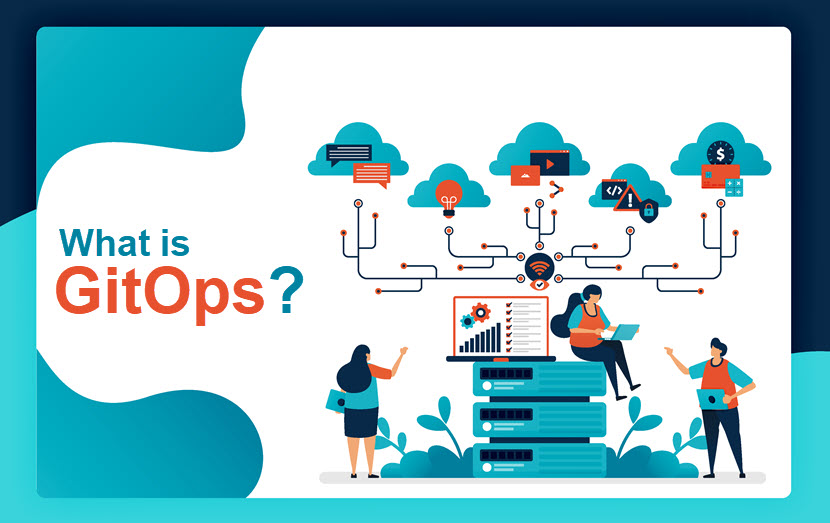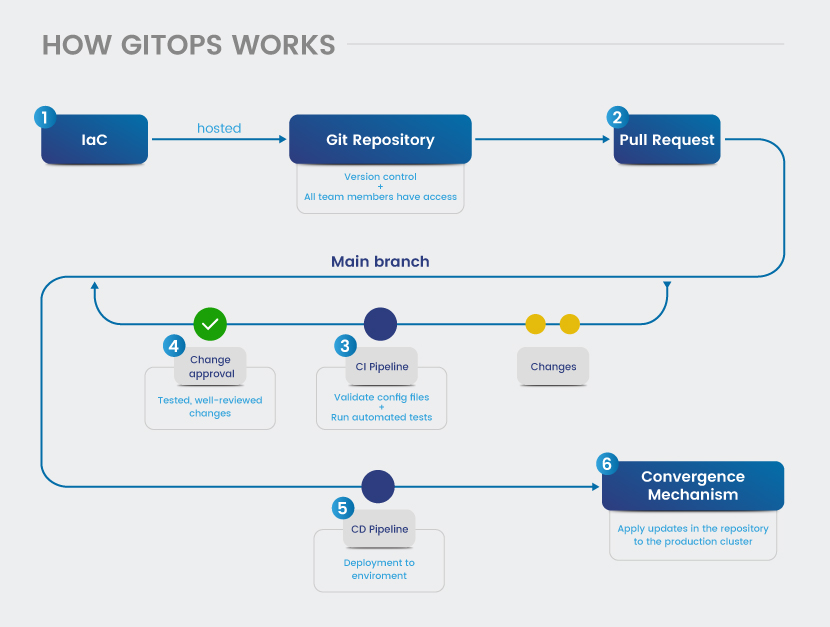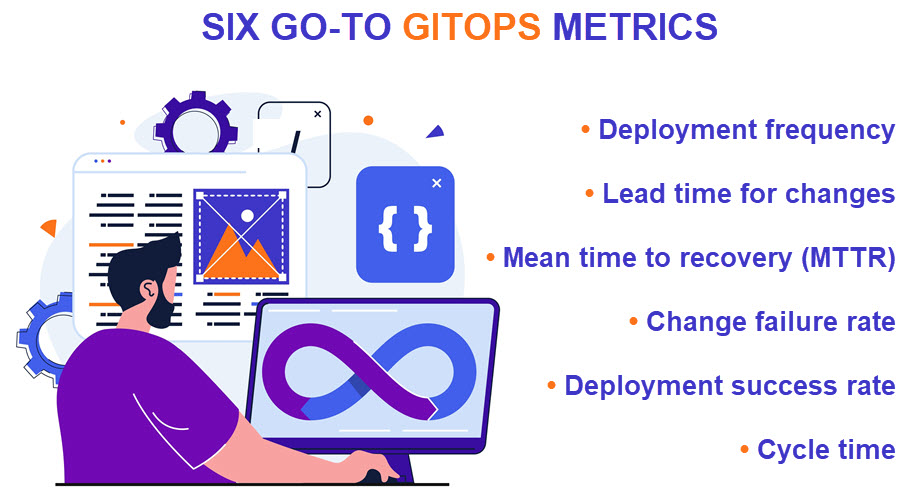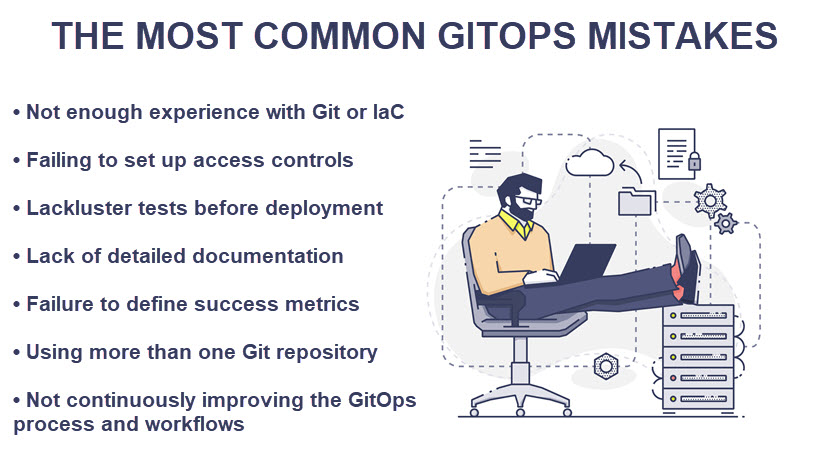What Is GitOps?
GitOps streamlines and automates the most manual-heavy aspect of SDLCs—infrastructure provisioning and management. GitOps makes DevOps infrastructure more elastic, consistent, and reliable, traits that require a small fortune to achieve if you rely on manual deployments.
This article explains what GitOps is and lists the benefits this strategy brings to software development teams and projects. Read on to get a clear picture of whether adopting GitOps is a worthwhile investment for your company.

Check your team's DevOps maturity level before adding GitOps to workflows. Teams not already accustomed to DevOps will struggle with GitOps so ensure developers have the necessary know-how before you introduce extra complexity to operations.
What Is GitOps?
GitOps is the practice of applying DevOps principles of app development to infrastructure management. With GitOps, developers treat infrastructure as code in the same way as app code to automate updates and make changes traceable.
Teams that adopt GitOps write infrastructure configuration files as code and keep them in a dedicated Git repository. Git acts as the single source of truth for all infrastructure, which enables:
- Reliable version control of configurations.
- High consistency as files generate the same environment every time you deploy them (in the same way app source code generates the same application binaries).
Once the team commits a change to the Git repository, a DevOps pipeline automatically deploys infrastructure updates without the need for human intervention.
GitOps is a relatively young strategy. Weaveworks, a UK-based company, developed the basis of the framework and coined the term in 2017. Since then, GitOps became the go-to practice for use cases that require reliable and scalable infrastructure, such as:
- Cloud-native architectures.
- Any infrastructure that involves Kubernetes.
- Microservices architectures.
- Pipelines with continuous delivery that automatically deploy changes to production.
- Hybrid and multi-cloud deployments.
GitOps offers a highly developer-centric experience. Infrastructure management takes place in the same version control system as app development, enabling teams to collaborate in a central location while benefiting from Git's built-in features.
New to Git? No worries—our beginner-friendly guide to Git is an excellent starting point for anyone unfamiliar with this powerful version control system.
What Is the Difference Between GitOps and DevOps
While there's a lot of overlap between GitOps and DevOps, these are two separate concepts:
- DevOps is the culture of integrating the work of development (Dev) and IT operations (Ops) teams. DevOps tools and practices break down silos between Dev and Ops while improving code quality and shortening the SDLC.
- GitOps is a subset of DevOps that specifically focuses on automating infrastructure management via Git. GitOps is the next step in the evolution of IaC, which itself originated as a DevOps best practice.
Here are a few other notable differences between GitOps and DevOps:
- GitOps is a specialized framework while DevOps is more of a philosophy that requires fundamental changes to the way a company creates software.
- DevOps does not necessitate the use of any specific tool. GitOps requires the team to use Git (although you have a wide selection of other tools you can use alongside Git).
- Some DevOps pipelines have manual triggers for deployments. With GitOps, triggers are always automatic and based on changes to the Git repository.
- You can have DevOps without GitOps, but not the other way around.
Both DevOps and GitOps work with any type of infrastructure, but their benefits are truly felt with cloud computing and bare metal cloud environments. The two strategies require the team to be familiar with IaC, plus both rely heavily on automation to speed up processes and fix issues before they impact the end-user.
Our article on the main DevOps roles and responsibilities covers everything you'll have to account for if you're adopting DevOps at your company.
How GitOps Works?
GitOps teams configure systems declaratively using tools like Terraform or Ansible. This approach focuses on the result (the desired state) rather than the exact steps for reaching the result. Here's what a simplified imperative statement (the opposite of the declarative approach) looks like:
- Install the following dependencies on the XZY machine.
- Download the code from website XYZ.
- Move the code to this directory.
- Repeat this process four more times for the following machines.
The declarative version of this process would simply read: the following five machines have software from this URL, installed in this directory. You describe the desired state for the target environment and the system automatically adjusts to the request.
GitOps teams store all the files with declarative states in a single Git repository. Storing files in Git enables version control that helps teams track infrastructure changes over time. Version control is also helpful for:
- Troubleshooting.
- Auditing.
- Rolling back to a previous state.
Once the team makes changes to the repository, a CI pipeline validates config files and runs automated tests after which any staff member can review and approve commits. Updates then merge into the main branch through a CD pipeline.
GitOps provides two main methods for applying changes to production environments:
- Pull method: The system continuously monitors the Git repository for updates. If there's a change, the system pulls the new configuration and applies it to the infrastructure.
- Push method (agentless): Developers make changes to the Git repository and the system immediately triggers to pull changes and apply them to the infrastructure.
Finally, the convergence mechanism applies updates made in the repository to the production cluster. The orchestrator compares the current state of the cluster with the updates in Git and makes changes until the actual and desired states are identical.

How to Get Started with GitOps
If your team already uses Git as its SCM tool and there's a properly set up DevOps pipeline, implementing GitOps is simple. All you should do is:
- Move all infrastructure code into a dedicated Git repository.
- Configure the CI/CD pipeline to make the repository a part of the delivery pipeline.
If your organization is low on the DevOps maturity scale and it doesn't use version control, start by setting up a Git repository. Git is platform-agnostic, so choose any local or cloud-based repository you're familiar with. Here are a few popular options:
- GitHub.
- BitBucket.
- Azure Repos.
- GitLab.
Train your team on declarative programming, Git's built-in features, and IaC. Try to bring in a few new experts with hands-on GitOps experience, but also organize training sessions for current staff members.
Next, you'll have to set up a CI/CD pipeline platform that automates the delivery process. The pipeline must track changes to the Git repository and automatically deploy them to the environment.
Use tools that are familiar to your team. In general, Jenkins and CircleCI are great options with any Git repository. BitBucket Pipeline and GitLab Pipelines require their own repositories.
Once a CI/CD pipeline is up and running, you need a GitOps operator. This mechanism acts as a "middleman" between the pipeline and the actual system. The three most popular options are:
- Kubernetes Operator.
- Azure Service Operator.
- Terraform Cloud Operator.
The operator ensures that the actual and the desired environment states match. The mechanism also provides continuous monitoring to maintain the desired state of your infrastructure.
Choose an infrastructure-as-a-service provider that provides on-demand, production ready environments that are cloud native and easily scalable. phoenixNAP's Bare Metal Cloud provides programmable infrastructure that can be deployed in less than two minutes. Learn more about Bare Metal Cloud, the cloud environment that brings bare metal performance!

GitOps Benefits
Below are the main benefits of adopting GitOps at your company:
- Streamlined infrastructure management: GitOps enables teams to manage infrastructure as part of the overall DevOps process. You test and deploy changes quickly with the help of CI/CD tools and automated deployments.
- Improved reliability: All infrastructure changes have thorough reviews and tests. Well-tested updates significantly lower the chance of errors and downtime.
- Faster deployments: Automatic infrastructure deployments occur as soon as updates merge into the main branch. Such a setup reduces the time required to deploy changes, which enables teams to release new features with more speed and frequency.
- Quick rollbacks: Git's version control enables a team to revert and roll back as necessary. You easily troubleshoot problems if new changes break something in the cluster.
- Empowered developers: Development teams get to perform tasks traditionally reserved for the ITOps. If developers wish to deploy a new app or change an existing one, all they do is update the repository and automated processes handle the rest.
- More inter-team collaboration: Just like DevOps, GitOps necessities collaboration between developers, operations teams, and other IT stakeholders.
- Less chance of configuration drift: Git provides a complete audit trail of changes for configuration files. Environments are highly consistent and you reduce the risk of configuration drift.
- Complete audibility: Git allows developers to track infrastructure over time. This audit trail of who did what to the cluster and when is valuable whenever something breaks or behaves unexpectedly.
- Compliance: The use of declarative infrastructure as code makes it easier to achieve compliance across the delivery pipeline.
- A security boost: GitOps enables teams to enforce Git-based security policies and centralize management. Updates get thorough reviews and require approvals before merging into the main branch, which lowers the danger of faulty or malicious code.
Concerned about IT security levels? Consider investing in threat modeling and start using proactive flaw detection to boost your security posture.
GitOps Drawbacks
While GitOps offers a range of benefits, there are a few potential drawbacks you must keep in mind. Here are the main problems of adopting GitOps:
- Hard to set up: The greatest challenge of GitOps is the initial setup of the process. The practice requires tight integrations and a lot of automation, which is often challenging to set up properly.
- Extra complexity: GitOps requires teams to adopt new workflows, which is challenging if you're unfamiliar with Git and DevOps practices. Many adopters must invest heavily in recruitment and staff training to deal with the steep learning curve.
- Compatibility issues: Some apps are not well-suited for GitOps. Many legacy systems that require manual intervention or specialized deployment processes are difficult (or even impossible) to integrate with GitOps.
- Resistance to change: Adopting GitOps requires a significant cultural shift towards collaboration, automation, and continuous improvement. Many teams are unenthusiastic about this change, which might cause problems during and after GitOps adoption.
- Keeping Git safe: Since Git is the only source of truth, the platform's repositories become a prime target for cyberattacks. You must control access to configuration files to prevent data breaches.
Our backup strategy guide explains how companies should protect their most valuable assets and ensure files are recoverable no matter what goes wrong.

Is GitOps Replacing DevOps?
No, GitOps is not replacing DevOps, nor is it trying to do so. GitOps is aiming to replace old-school infrastructure management that relies heavily on manual tasks and tests.
Companies use GitOps alongside other DevOps practices and tools to achieve higher levels of automation and speed up time-to-market. GitOps supports DevOps initiatives with:
- Flexible and scalable infrastructure that makes teams more agile.
- The ability to track, roll back, and audit changes, which significantly simplifies the way teams troubleshoot issues.
- Further incentives for developers, ITOps specialists, and other staff members to collaborate on configuration management.
- The ability to deploy and manage infrastructure automatically while ensuring consistency across all environments.
If you're new to both GitOps and DevOps, we'd recommend you first define an in-depth IT strategy plan before exploring more advanced practices and strategies.
Are Your Teams and Workflows a Good Fit with GitOps?
GitOps is not the right choice for every team and project. Some companies view reliance on a single tool and automatic infrastructure builds as less than ideal.
However, if your team has the necessary know-how and you've already invested in DevOps, adopting GitOps is a no-brainer.
The practice translates all the manual, time-consuming infrastructure management tasks into an automated pipeline, improving the visibility, reliability, and stability of your infrastructure.